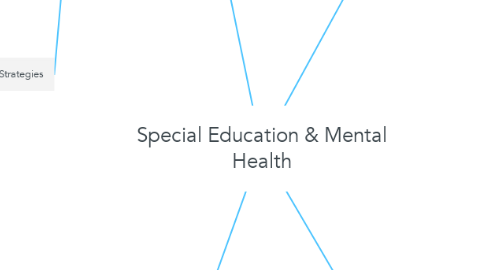
1. Inclusive
1.1. Social Model of Disability
1.1.1. Find Disability Unsurprising
1.1.2. Understand disability is framed by societal barriers
1.1.2.1. I had many kids at summer camp who had exceptionalities that I was never trained to support (i.e. ADHD), therefore when I "messed up", I pitied both them and myself due to a lack of understanding
1.1.2.2. Summer camps are a place that needs more attention to training volunteers on supporting campers with disabilities. Most volunteers are under 18 years old
1.1.2.2.1. Accessibility to Ontarians with Disabilities Act is mandatory training, but ends up being long and boring to a room full of teenagers
1.2. Strengths-Based Thinking
1.2.1. People-First Language
1.2.2. Learn student interests, skills, gifts as tools for teaching
1.2.3. Promote Self-Advocacy
1.2.3.1. Model
1.2.3.2. Language & terminology
1.2.3.3. Tools & resources
1.3. Build Executive Functioning Skills
1.3.1. Supply Prompts
1.3.2. Model Effective Strategy
1.3.3. Provide Opportunities to Apply Knowledge
1.3.4. ASD: Sensory Processing Diffiulties
1.4. Instructional Strategies
1.4.1. Differentiate Instruction to Accomodate all Students
1.4.1.1. Reduce Cognitive Load
1.4.1.1.1. Guided Practice
1.4.1.1.2. Assistive Tech
1.4.1.1.3. Chaining & Shaping
1.4.1.2. Promote Student Autonomy
1.4.1.2.1. Provide Choice
1.4.1.2.2. Utilize Tech & Assistive Devices
1.4.1.3. Assistive Technology
1.4.1.3.1. Makey-Makey
1.4.1.3.2. Support Software (i.e. translation, text-to-speech)
1.4.1.3.3. Motor Skills Support (i.e. speech-to-text)
1.4.2. Apply UDL to "extend learning to all students" (TDSB Special Education Plan, 2019, p.34)
2. Proactive
2.1. Social-Emotional Learning Focus
2.1.1. Build emotional intelligence
2.1.2. Alternative Expectations on IEP
2.2. Foster an Equitable Classroom Community at the start of the year
2.2.1. Understanding What Equity Is
2.3. Individual Education Plan
2.3.1. First IEP goes home within 30 days of start of school year
2.3.2. Modifications, Accommodations & Alternative Expectations
2.3.2.1. Accommodations
2.3.2.1.1. Environmental
2.3.2.1.2. Instructional
2.3.2.1.3. Assessment
2.3.3. Apply for SEA
2.4. Use additional supports (see School Support Team & Special Education Supports)
2.5. Seek Student Input
2.6. ABA Principles
3. Collaborative
3.1. Provincial Government
3.1.1. Ministry of Children, Community and Social Services
3.1.1.1. Ontario Autism Program
3.1.1.2. Ontario Disability Support Program (Income & Employment Supports for adults)
3.1.2. Ministry of Education
3.2. School Board
3.2.1. Special Equipment Amount (SEA) funding application specifically for students with special needs as recommended by a qualified official
3.2.2. School Support Team
3.2.2.1. Professional Support Services
3.2.2.1.1. Qualified Professionals
3.2.2.1.2. Assessments
3.2.2.1.3. Referrals
3.2.3. Identification, Placement and Review Committee (IPRC) identifies exceptional pupils
3.2.4. Special Education Supports
3.2.4.1. In-School Team
3.2.4.1.1. Special Education Consultants
3.2.4.1.2. Child & Youth Workers
3.2.4.1.3. Educational Assistants
3.2.4.1.4. ASD Teams
3.3. Parents
3.3.1. Students
3.3.1.1. Students over 16 have copy of IEP
3.3.1.2. "Learn about the Learner from the Learner" (Kluth, 2010)
3.3.2. Parent-teacher Relationships
3.3.2.1. Host events for parents
3.3.2.2. Create opportunities for their involvement beyond volunteering
3.3.2.3. Connect them to community & cultural programs
3.3.3. IEP Consultation
4. Barriers
4.1. Availability of Resources & Funding
4.1.1. SES of neighbourhood
4.1.2. Parental Income
4.1.3. Lack of Special Education Support (i.e. limited number per board going from school to school)
4.2. Deficit Thinking
4.2.1. Focus on weakness instead of strength
4.2.2. Limiting mindset for teacher & student
4.3. Lack of Parental Support
4.3.1. Parents may not want to test their child
4.3.1.1. 1st Practicum: Mother of student with behavioural challenges did not want him to have an IEP
4.3.1.2. Ignorance, neglect, denial, dismissal, incorrect attribution
4.3.2. If there is no official diagnosis, it is more difficult to get funding (see SEA)
4.4. Waiting Lists
4.4.1. Referrals & Assessments
4.4.1.1. 1st Practicum: My AT told me the process of referring a student to a psychologist took a long time
4.4.2. SEA
4.4.3. IRPC
4.4.4. Professional Support Services & Experts
